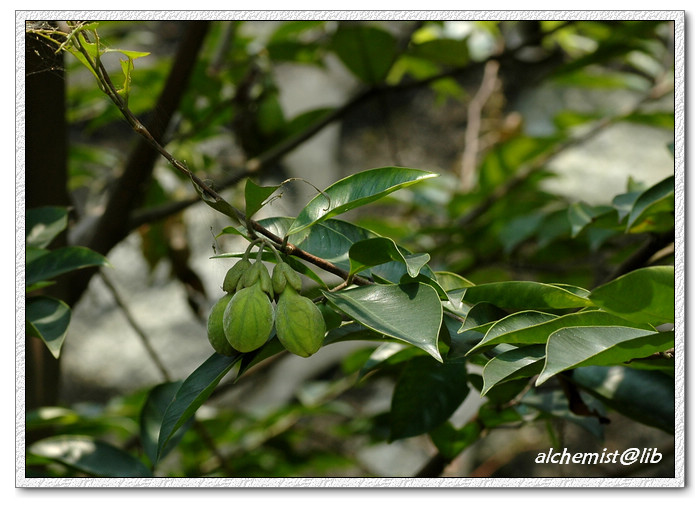- Scientific Name: Aquilaria sinensis (Lour.) Spreng.
- Ref: Syst. Veg. 2:356. 1825
- Synonyms: Agallochum grandiflorum (Benth.) Kuntze; A. sinense (Lour.) Kuntze; Aquilaria grandiflora Benth.; Ophispermum sinense Lour.
- English Common Name: incense tree
- Chinese Common Name: 土沉香 tǔ∙chénxiāng
- Japanese Common Name: シナジンコウ [シナ沈香] shinajinkō
- Family: Thymelaeaceae
- Genus: Aquilaria
- Distribution: Lowland forests, sunny places on slopes or along roadsides. Fujian, Guangdong, Guangxi, Hainan.
- Photo: 06/21/2009, South China Botanical Garden, Guangdong
Trees 5-15 m tall. Bark dark gray, smooth; branchlets terete, rugose, puberulous, glabrescent. Petiole 5-7 mm, pubescent; leaf blade dark or purple-green, glossy adaxially, light green abaxially, orbicular or elliptic to oblong, sometimes obovate, 5-9 × 2.8-6 cm, leathery, both surfaces glabrous, but sometimes puberulous along margin, base broadly cuneate, apex acuminate or acute, apiculate; lateral veins 15-20 pairs, more conspicuous abaxially, veins and veinlets slender, subparallel, obscure. Inflorescence terminal, a loose panicle of umbels, many flowered. Flowers fragrant at night; pedicel 5-10 mm, densely yellow-gray pubescent. Calyx yellowish green; tube narrowly campanulate, 5-6 mm, exterior and interior densely pubescent; lobes 5, ovate, 3-5 mm, both surfaces pubescent, apex rounded and obtuse, or acute. Petaloid appendages 10, scalelike, inserted at throat of tube, obviously densely pilose at anthesis. Stamens 10; filaments ca. 1 mm; anthers linear-oblong, ca. 1.5 mm. Ovary ovoid, densely grayish white hairy; style obsolete or nearly so; stigma capitate. Capsule shortly stipitate, ovoid, 2-3 × ca. 2 cm, densely yellow pubescent, base tapering, apex apiculate; pericarp thin, smooth when dried. Seeds dark brown, ovoid, ca. 10 × 7.5 mm, white sericeous or glabrous; funicle conspicuous, ca. 1.5 × 0.4 cm, longer than seed, tapered at base, broad and compressed below seed. Fl. spring-summer, fr. summer-autumn. (Flora of China)
